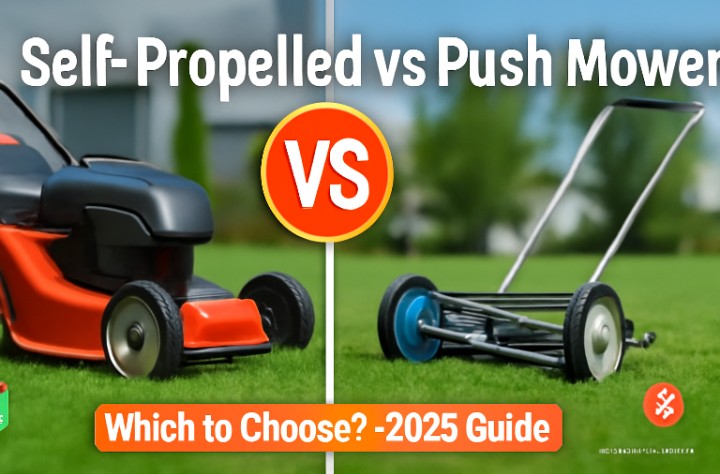Buying a lawn mower used to be straightforward. Now? Walk into Home Depot or Lowe’s and you are staring at what feels like fifty different machines. The big choice usually comes down to self-propelled or push mowers.
Both get your grass cut, obviously. But the way they work is night and day. One moves itself forward while you guide it. The other makes you do all the pushing. How big your yard is, whether it’s flat or hilly, and what you can afford to spend all play into this.
Let’s dig into what actually matters here. By the time you finish reading, you will know exactly which one fits your situation.
WHAT IS A PUSH MOWER?
A push mower is about as basic as it gets. You provide every bit of forward motion. The engine, if it has one, only turns the blade spinning underneath.
Two types fall into this bucket. Manual reel mowers have zero engine. You push and that cylinder of blades spins around. Then there are gas or electric push mowers where a motor runs the blade. But you are still pushing the whole thing across your lawn yourself.
Think about pushing a grocery cart full of stuff. That’s basically what you are doing. You control the speed, the direction, everything. It sits there like a rock until you move it.
Weight stays reasonable on these. Most fall between 50 and 80 pounds. They work great if your yard’s on the smaller side and pretty flat, like under a quarter acre.
WHAT IS A SELF-PROPELLED MOWER?
This is where you get more complexity. Self-propelled mowers have a drive system built in. The engine does double duty: it spins the cutting blade and powers the wheels. You’re there steering it, but the mower moves itself forward.
The drive connects to front wheels, rear wheels, or all four depending on the model. There’s a transmission inside that sends power from the engine to whatever wheels are doing the driving.
Most have a lever or bar you squeeze to make it go. Hold it down, mower moves. Let go, it stops. A lot of them let you adjust speed somewhere between 1 and 4 miles per hour.
These weigh more, typically 70 to 100 pounds. But the key difference? You are not muscling that weight around. The engine handles that part.
KEY DIFFERENCES: SELF-PROPELLED VS. PUSH MOWER
Ease of Use
Self-propelled mowers remove most of the physical work. You are just walking behind it, steering when needed. Great option if your back bothers you or your knees are not what they used to be.
Push mowers make you work for it. You are pushing 60 to 80 pounds around your entire property. That’s a real workout, especially on hot summer afternoons.
Lawn Size & Terrain
Got a smaller yard? Push mowers work perfectly fine for anything under a quarter acre. They do best on smooth, flat surfaces.
Larger yards need that self-propelled boost. Once you cross that quarter acre line, pushing starts wearing you down. Got slopes or hills? Self-propelled handles those way easier.
We have tried both types extensively here at Ex Landscaper. Your terrain usually makes the decision for you more than anything else.
Maneuverability
Push mowers turn super easily. Tight spaces around garden beds? Not a problem. You just lift the front a little and swing it around.
Self-propelled models need more space for turns. You have to release the drive before pivoting. Some people with smaller, cluttered yards find this annoying.
Physical Effort
Here’s where things get really different. Self-propelled mowers drop your exhaustion level by maybe 60 to 70%. You are walking, not wrestling with equipment.
Push mowers give you exercise whether you want it or not. Some homeowners actually like this. But thirty minutes in, especially on a humid day, you are going to feel it.
Price & Budget
Push mowers are cheaper upfront. Basic models start around $130. Even really nice ones rarely go past $800.
Self-propelled models begin closer to $330 for entry level stuff. High end models with extra features can hit $2,200 or more. You are potentially spending three times as much.
Maintenance
Push mowers keep maintenance pretty straightforward. Sharpen the blade twice during mowing season. Spray off the deck after you are done. Change the oil once a year on gas models.
Self-propelled mowers need more attention. Drive belts wear out over time. The transmission needs checking now and then. Engine maintenance gets more involved.
Fuel/Energy Efficiency
Push mowers use less fuel or battery. Power only goes to that spinning blade. Nothing gets used moving the wheels.
Self-propelled models eat up 10 to 25% more fuel or electricity. The drive system needs energy too. Over a whole season, you’ll notice the difference.
DRIVE SYSTEM TYPES IN SELF-PROPELLED MOWERS
Front-Wheel Drive (FWD)
Front-wheel drive works well on flat lawns. The front wheels pull the mower along. Turning feels pretty natural since you are lifting the front slightly anyway.
These cost less than other drive types. You will find them all over stores. Good choice for yards with lots of flower beds and trees to navigate around.
But hills? That’s where they struggle. When your grass bag fills up, weight shifts to the back. The front wheels lift up and lose grip.
Rear-Wheel Drive (RWD)
Rear-wheel drive handles slopes really well. The back wheels push everything forward. Weight naturally sits over those drive wheels, which means better traction.
Something interesting happens when the bag fills up: it actually works better. That extra weight presses the rear wheels down harder. More grip, not less.
RWD costs more than FWD. But if your property has any incline at all, it’s worth it.
All-Wheel Drive (AWD)
All-wheel drive is the premium choice. Every wheel gets power. Traction stays maxed out no matter what you’re rolling over.
Steep hills? No sweat. Bumpy ground? Handles it smoothly. These stay balanced better than anything else available.
You are paying top dollar though. AWD is the most expensive category. They are also heavier and burn through more fuel.
GAS VS. ELECTRIC: POWER SOURCE OPTIONS
Gas-Powered Mowers
Gas engines deliver serious cutting power. Tall, thick grass does not bog them down. You can run them as long as you want, just add more gas.
But there are downsides. They are loud, often 90 decibels or higher. You are dealing with oil changes, spark plug swaps, air filter cleaning. Plus they put out exhaust.
Battery-Powered (Electric) Mowers
Electric mowers run way quieter, around 75 decibels. No gas to buy, no oil to change, no fumes. Just plug it in overnight and mow the next day.
Battery technology got way better in 2025. Modern lithium batteries run 45 to 60 minutes on a charge. That’s plenty for most residential yards.
The catch? You need recharge time between sessions. Batteries also lose capacity as they age. New ones cost $100 to $300 when replacement time comes.
IMPORTANT FEATURES TO CONSIDER
Cutting Deck Size
Deck size determines how wide a strip you cut. Smaller decks around 16 to 20 inches fit through tight spots. Larger decks from 21 to 30 inches finish faster.
Try matching deck width to your yard. Property under 3,000 square feet? A 20-inch deck is plenty. Bigger places benefit from 22 inches or wider.
Cutting Functions
Most modern mowers offer three options. You can mulch, bag, or side discharge. Switch between them depending on conditions.
Mulching chops clippings really fine so they decompose fast. Bagging collects everything for disposal. Side discharge shoots clippings out as you go.
Speed Control Systems
Variable speed lets you adjust pace. Some models have a few preset speeds. Others give you a dial for fine tuning.
Toro makes this Personal Pace system that’s actually clever. It automatically matches however fast you are walking. Speed up, it speeds up. Slow down, it slows down too.
Starting Mechanism
Electric start is just pushing a button. No yanking on cords. Battery-powered starting systems make things easy.
Pull-start setups still exist on budget models. They work but require some muscle. Cold mornings can be frustrating when you are pulling five times to get it going.
Smart Features (2025)
Some newer models have actual sensors now. They measure grass thickness and adjust blade speed automatically. Hit thick grass? More power. Thin area? Engine backs off.
Advanced battery systems squeeze more runtime from each charge. They adjust power based on what you are cutting. Some even alert you when maintenance is coming due.
WHEN TO CHOOSE A PUSH MOWER
Smaller properties are where push mowers make sense. Anything under 5,000 square feet (less than a quarter acre) works fine. Most people finish in 20 to 30 minutes.
Flat terrain makes pushing easy. No hills means you are not fighting gravity. Your lot really should be mostly level.
Tight budget? Push mowers save you several hundred dollars upfront. They cost less long term for maintenance and fuel too.
Want simple maintenance? These are as basic as it gets. Fewer parts means less stuff that can break.
Lots of stuff to maneuver around? Push mowers navigate better. Trees, garden beds, yard decorations are easier to work around.
WHEN TO CHOOSE A SELF-PROPELLED MOWER
Larger properties really need that self-propelled help. Anything over a quarter acre means you are spending significant time mowing. The drive system prevents exhaustion.
Hills and slopes are where these shine. RWD or AWD models climb effortlessly. You steer, they provide the muscle.
Want to reduce physical strain? Self-propelled models are game changers. People with back problems, bad knees, or arthritis find them essential.
Physical limitations should not stop you from maintaining your yard. These machines level the playing field.
Need to wrap up quicker? Self-propelled mowers cover ground faster. You walk normally while it powers itself forward.
TOP RECOMMENDED MODELS (2026)
Best Self-Propelled Mowers
Ryobi leads in battery-powered options right now. Their 40V system delivers consistent power. Runtime matches gas mowers these days.
DeWalt makes professional grade electric models. Contractors use them every day. Durability and power are excellent.
Echo’s gas-powered self-propelled mowers stay popular. Engines start reliably even after sitting all winter. The LM-2119SP gets great reviews consistently.
Best Push Mowers
Budget conscious buyers like basic push models from Craftsman and Troy-Bilt. They are reliable without fancy features. Prices start around $200.
Manual reel mowers are making a comeback. Silent, zero emissions, good exercise. Perfect for smaller, well kept lawns.
MAINTENANCE TIPS
Push Mower Maintenance
Sharpen blades at the start of mowing season. Dull blades tear grass instead of cutting cleanly. This stresses your lawn.
Clean underneath the deck every few uses. Grass clippings build up and harden. Performance drops when this accumulates.
Check oil on gas models before each use. Change oil once per season or every 50 hours.
Self-Propelled Mower Maintenance
Inspect the drive belt regularly. Look for cracks, fraying, or looseness. Most need replacement every 2 to 3 years.
Engines need consistent care. Follow whatever service schedule the manufacturer recommends. Skipping maintenance catches up with you.
Battery models need attention too despite being electric. Store batteries at room temperature in winter. Don’t let them sit completely dead.
COST COMPARISON
Purchase prices vary quite a bit. Push mowers range from $130 to $800. Self-propelled models go from $330 up to $2,200 or more.
Ongoing maintenance differs too. Push mowers usually need $50 to $100 yearly. Self-propelled versions run $100 to $200 per year.
Fuel costs matter for gas models. Expect to spend $20 to $40 per season on push mowers. Self-propelled units use $30 to $60 annually.
Electric models shift costs to electricity. Charging costs almost nothing per session. But replacement batteries eventually cost $100 to $300.
FINAL VERDICT: WHICH SHOULD YOU CHOOSE?
Your property size matters most. Under a quarter acre and fairly flat? Push mowers work fine.
Over a quarter acre or hilly? Self-propelled saves massive time and energy. The investment pays off fast.
Budget plays a role too. Money tight right now? Get a push mower. You can always upgrade later.
Be honest about physical capability. Consider your stamina and any health issues. Self-propelled removes physical barriers.
Think about your plans. Staying in your home long term? Quality self-propelled equipment makes sense. Moving soon? Basic push mower might be sufficient.
The END
Both mower types have clear advantages. Push mowers offer simplicity, lower cost, and easy maneuvering. Self-propelled models provide power, convenience, and less exhaustion.
Match your choice to what you actually need. Don’t buy more machine than necessary. But don’t go too cheap and regret it either.
The right mower changes lawn care from dreaded chore to manageable task. Take time choosing carefully. Your back will thank you later.
FAQS
Can you push a self-propelled mower manually?
Yes, but it’s harder than pushing a regular push mower. The drive system adds weight and resistance. Most are 15 to 20 pounds heavier. You will feel that difference quickly.
Are self-propelled mowers worth the extra cost?
For larger or sloped yards, absolutely. The time saved and reduced fatigue justify the price. Smaller, flat yards might not need that investment.
What’s better for hills: FWD, RWD, or AWD?
RWD handles moderate slopes best. AWD conquers steep terrain. FWD struggles on inclines, especially with a full grass bag.
How often should I maintain my mower?
Clean it after every use. Sharpen blades twice per season. Change oil annually on gas models. Check belts and filters regularly. Good maintenance extends lifespan significantly.






